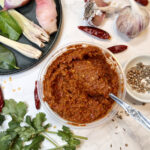Shrimp sinigang is a simple comfort meal that’s bursting with flavor! This classic Filipino soup is packed with tender shrimp, fresh vegetables, and a tangy tamarind broth that’s sure to warm your heart and soul. So grab your ladle and get ready to savor every spoonful of this delicious dish!
What is Shrimp Sinigang?
Shrimp Sinigang is a classic Filipino dish that’s loved by many for its tangy and savory flavor profile. It’s a hearty soup made with fresh shrimp, a variety of vegetables such as okra, radish, eggplant, and tamarind which gives the soup its distinct sour taste.

One thing that sets Shrimp Sinigang apart from other soups is that it’s a complete meal in itself. The soup is packed with nutrients from the vegetables, protein from the shrimp, and carbohydrates from the rice that’s usually served alongside it. It’s a perfect dish for those who want to eat healthy but still want something filling and satisfying.
As a child, I always remembered my mom making Shrimp Sinigang for our family during rainy or snow days. It was always a crowd-pleaser, and the whole family would gather around the dining table, enjoying the soup with a bowl of steamed rice. I was always the type to make my sinigang extra sour because it would cut through the richness and sweetness of the shrimp!

When it comes to cooking Shrimp Sinigang, there are many variations to the recipe. Some people prefer to use other souring agents such as calamansi or guava, while others prefer to add other ingredients such as taro or tomato. Regardless of the recipe, the key to making a delicious Shrimp Sinigang is to make sure that the broth is flavorful and balanced –so always be sure to adjust the sourness to your liking.
Looking for more classic Filipino recipes? Here’s a couple more to give a try:
- Tortang Talong (Eggplant Omelette)
- Bistek (Filipino Beef Steak)
- Pancit Bihon (Filipino Rice Noodles)
- Tofu Sisig (Crispy Tofu Stirfry)
Ingredients
- Shell-on, cleaned, deveined shrimp: For this recipe you’ll need whole shrimps with their shells and heads still on to add that extra boost of shrimp flavor to our soup. Make sure to reserve some time to clean these shrimps properly (e.g., removing the horns, legs, whiskers, and digestive tract) for a more cleaner, less-gritty soup.
- Tomatoes, onion, white radish, eggplant, bokchoy, string beans, okra, chili peppers: These will be the main vegetables going into our soup. Feel free to omit or add more veggies into the mix, but this is usually the standard combination you’ll see in most sinigang recipes.
- Tamarind concentrate: This recipe uses tamarind concentrate that you can typically purchase from a container or as a block of tamarind pulp that you can simply hydrate with hot water to form a paste. It is the KEY ingredient to a good sinigang since tamarind lends the soup its distinct sourness and mild sweetness.
- Fish sauce, salt: The saltiness and umami notes of the fish sauce and salt help to bring out the flavors of the soup and hilight the taste of the shrimp.
Instructions for Shrimp Sinigang
In a moderately large pot, bring the five cups of water to a boil. Once boiling, add in the tomatoes, onions, and white radish. Turn the heat down to medium and let the vegetables simmer and infuse their flavors for 10 minutes until softened.

Pour in the tamarind paste, fish sauce, and salt. Mix until well combined.

Add in the cleaned shrimp, eggplant, bokchoy, string beans, okra, and chili peppers. Close the pot with a lid and simmer for an additional 5 minutes just until the shrimp is cooked and the vegetables have softened.

Taste the soup, and season with more salt, fish sauce, and/or tamarind paste to preference. Serve warm. Enjoy!

Disclosure: Some links on this page are affiliate links, meaning that at no additional cost to you, we may receive compensation from purchases made through these links. As an Amazon Associate, I can earn from qualifying purchases.








Pingback: Hong Shao Rou (Red Braised Pork Belly) | Iankewks
Pingback: Khao Soi (Thai Curry Noodle Soup) | Iankewks
Pingback: Pork Adobo (adobong baboy) | Iankewks